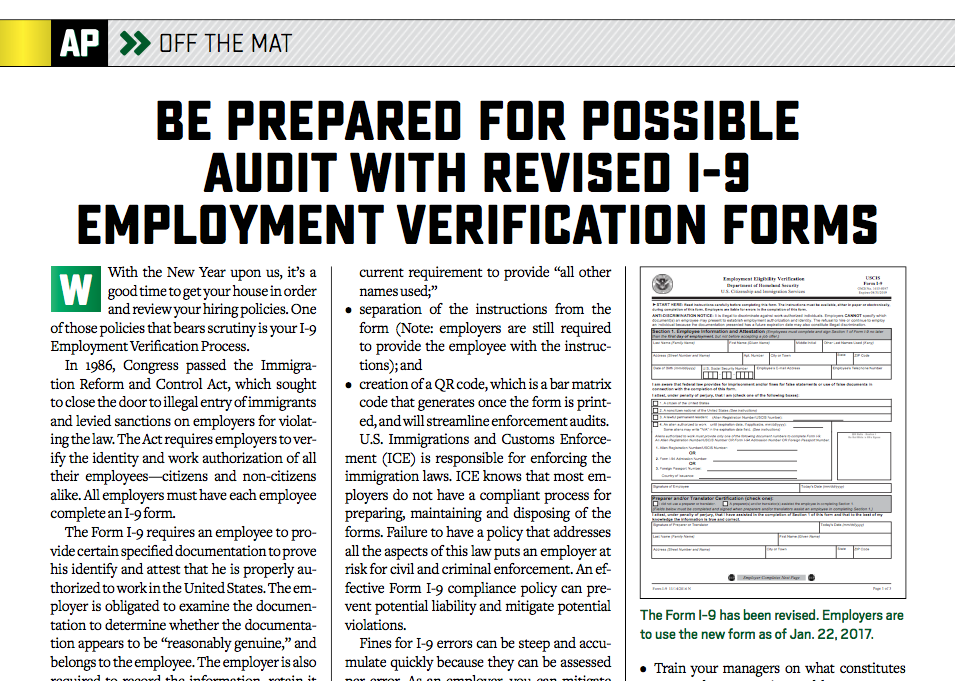Be Prepared for Possible Audit with Revised I-9 Employment Verification Forms
BY Lorraine D'Angelo

With the New Year upon us, it’s a good time to get your house in order and review your hiring policies. One of those policies that bears scrutiny is your I-9 Employment Verification Process.
In 1986, Congress passed the Immigration Reform and Control Act, which sought to close the door to illegal entry of immigrants and levied sanctions on employers for violating the law. The Act requires employers to verify the identity and work authorization of all their employees—citizens and non-citizens alike. All employers must have each employee complete an I-9 form.
The Form I-9 requires an employee to provide certain specified documentation to prove his identify and attest that he is properly authorized to work in the United States. The employer is obligated to examine the documentation to determine whether the documentation appears to be “reasonably genuine,” and belongs to the employee. The employer is also required to record the information, retain it and make it available for inspection by the government on a minimum of three day’s notice.
Revision, Enforcement
Effective Jan. 22, 2017, employers must use the revised Form I-9 (edition dated Nov. 14, 2016) to verify the identity and work eligibility of every new employee hired after Nov. 6, 1986. (Employees already employed will only have to re-fill out a form if re-verification is determined to be required.) This revised form will expire Aug. 31, 2019, and the government should issue a new one.
The revised form aims to reduce the technical errors for which employers may be fined. Some of the changes include:
- field validation to ensure data is entered correctly;
- dropdown menus;
- embedded instructions for completing each field;
- the requirement for a worker to provide “other last names used” rather than the current requirement to provide “all other names used;”
- separation of the instructions from the form (Note: employers are still required to provide the employee with the instructions); and
- creation of a QR code, which is a bar matrix code that generates once the form is printed, and will streamline enforcement audits.
U.S. Immigrations and Customs Enforcement (ICE) is responsible for enforcing the immigration laws. ICE knows that most employers do not have a compliant process for preparing, maintaining and disposing of the forms. Failure to have a policy that addresses all the aspects of this law puts an employer at risk for civil and criminal enforcement. An effective Form I-9 compliance policy can prevent potential liability and mitigate potential violations.
Fines for I-9 errors can be steep and accumulate quickly because they can be assessed per error. As an employer, you can mitigate your risk by making sure your policy addresses the proper preparation of the I-9 forms, the maintenance of those forms and their disposal. Here are some tips that address the most common errors in each of the three aforementioned areas.
Preparation
- Make certain that you are using the most current Form I-9. As previously noted, the Form I-9 was revised and employers were to begin using it Jan. 22, 2017.
- Make certain that the form is fully completed correctly, double checking that the information is legible, your dates are correct, no signatures are missing and all boxes are completed. The revised form is more computer friendly and easier to complete on a computer, including drop-down lists and calendars for filling in dates, on-screen instructions for each field, easy access to the full instructions, and an option to clear the form and start over.
- Train your managers on what constitutes proper documentation and how to recognize if it is “reasonably genuine.”
- Educate your managers on the importance of asking for the right identifying documents from the lists, A, B and C, of acceptable identifying documents. Asking for too many may expose you to claims of discrimination and asking for too few may result in an incomplete Form I-9. Also, be aware of what you can and cannot ask for. For instance, providing a Social Security number on Form I-9 is voluntary for all employees unless you are an employer participating in the USCIS E-Verify program.
- Complete the Form I-9 in a timely manner. Forms must be completed within three (3) days of the employee’s first day of work, including the employee completing section one, providing the identifying documents and having those documents verified. If re-verification is required, employers must have a system to track and update the employee’s information and supporting documentation.
Maintenance
- Employers must retain the Form I-9 if the individual works for the employer. If the employee has been terminated, the employer is required to maintain the forms for either one year after the termination date or three years after the date of hire, whichever is later. Failure to destroy the forms within the time frame may subject an employer to fines. And, if you are audited and still have the old forms, the errors found on those outdated forms can result in fines. Having a timed process to regularly purge these forms in a way that protects the sensitive information is highly recommended.
- An employer may maintain the forms in paper, microform or electronic copy. There are specific guidelines for each type of retention. Whatever type of storage system an employer chooses, the employer must ensure reasonable controls to safeguard the integrity, accuracy and reliability of the system. When using an electronic system, an employer must also retain descriptions of the procedures relating to its use and implement an effective records security program.
- Implement a regular automated process for reminding your HR department to purge these records.
Disposal
- Because the records contain sensitive employee data, an employer must take care when disposing of the records. (Perhaps, it is also a good time to check your Document Retention and Destruction Policy.)
For the complete handbook on the proper completion, maintenance and disposal of Form I-9, go to the USCIS website . And remember, starting Jan. 22, 2017, employers should be using the revised form.
 Lorraine D’Angelo, a nationally-recognized expert on legal and regulatory risk management, is the president of LDA Compliance Consulting Inc. She has more than 25 years of experience in the construction industry, including a recent tenure as senior vice president for ethics and compliance at a global construction company. D’Angelo is an accredited ethics and compliance professional and a leading expert on small, women-owned, minority and DBE matters, programs and policy implementation. For more information, contact her at (914) 548-6369 or Lorraine@ldacomplianceconsulting.com.
Lorraine D’Angelo, a nationally-recognized expert on legal and regulatory risk management, is the president of LDA Compliance Consulting Inc. She has more than 25 years of experience in the construction industry, including a recent tenure as senior vice president for ethics and compliance at a global construction company. D’Angelo is an accredited ethics and compliance professional and a leading expert on small, women-owned, minority and DBE matters, programs and policy implementation. For more information, contact her at (914) 548-6369 or Lorraine@ldacomplianceconsulting.com.
